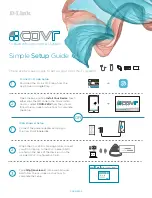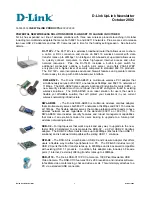
C
HAPTER
1
| Introduction
Description of Capabilities
– 20 –
◆
Easy setup and management through an easy-to-use web browser
interface on any operating system that supports TCP/IP.
◆
Compatible with all popular Internet applications.
A
PPLICATIONS
Many advanced networking features are provided by the Mini Broadband
Router:
◆
Wired LAN
— The Mini Broadband Router provides connectivity to
wired Ethernet devices, making it easy to create a network in small
offices or homes.
◆
Internet Access
— This device supports Internet access through a
WAN connection. Since many DSL providers use PPPoE, PPTP, or L2TP
to establish communications with end users, the Mini Broadband Router
includes built-in clients for these protocols, eliminating the need to
install these services on your computer.
◆
Shared IP Address
— The Mini Broadband Router provides Internet
access for up to 253 users using a single shared IP address account.
◆
Virtual Server
— If you have a fixed IP address, you can set the Mini
Broadband Router to act as a virtual host for network address
translation. Remote users access various services at your site using a
static IP address. Then, depending on the requested service (or port
number), the Mini Broadband Router can route the request to the
appropriate server (at another internal IP address). This secures your
network from direct attack by hackers, and provides more flexible
management by allowing you to change internal IP addresses without
affecting outside access to your network.
◆
DMZ Host Support
— Allows a networked computer to be fully
exposed to the Internet. This function is used when NAT and firewall
security prevent an Internet application from functioning correctly.
◆
Security
— The Mini Broadband Router supports security features that
deny Internet access to specified users, or filter all requests for specific
services. WPA (Wi-Fi Protected Access) and MAC filtering provide
security over the wireless network.
◆
Virtual Private Network (VPN) Passthrough
— The Mini Broadband
Router supports the passthrough of three of the most commonly used
VPN protocols – IPsec, PPTP, and L2TP. These protocols allow remote
users to establish a secure connection to another network. If your
service provider supports VPNs, then these protocols can be used to
create an authenticated and encrypted tunnel for passing secure data
over the Internet (that is, a traditionally shared data network). The
VPN-passthrough protocols supported by the Barricade are briefly
described below.
■
IPsec (Internet Protocol Security) —
Encrypts and
authenticates entire IP packets and encapsulates them into new IP
packets for secure communications between networks.
Содержание SMCWBR11S-N
Страница 1: ...BarricadeTM N 150Mbps Wireless N Mini Broadband Router SMCWBR11S N USER GUIDE...
Страница 137: ...SMCWBR11S N...















































